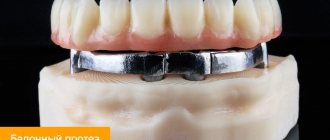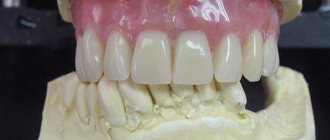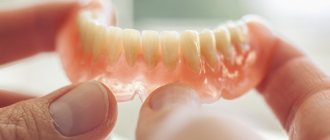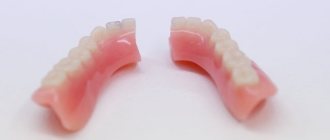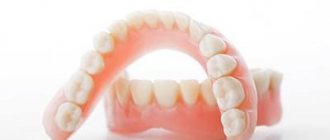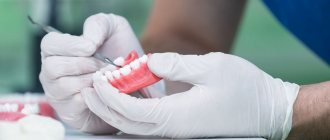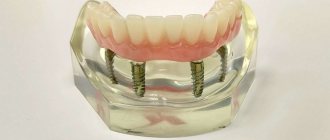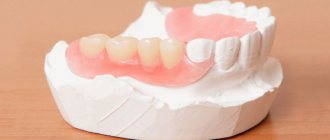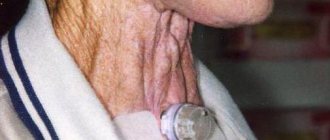20.05.2018
8045
Sign up for a free consultation:
- 1 Reasons for poor fixation
- 2 Consequences of a loose prosthesis
- 3 What to do?
- 4 How to do without dentures?
If the denture is loose on the teeth, this situation is not normal and requires the help of a dentist. Regardless of what type of prosthesis, the structure must hold tightly and not cause discomfort. In rare cases, due to the peculiarities of human anatomy, in the complete absence of teeth, it is difficult to create an ideal fixation structure. In this case, the doctor will advise installing implants as supports to securely attach the prosthesis.
Why does the bridge structure wobble?
The reasons for the problem may be the following:
- One of the supporting teeth has fallen out or broken;
- Two supporting teeth collapsed;
- The fastening composition ceased to perform its task.
- The prosthesis has expired;
- The material has worn out;
- There is an inflammatory prosthesis;
- Caries develops under the crown;
- The bridge is fixed to units with poorly treated canals, to long-treated canals, or to living teeth.
If your denture begins to wobble or wobble, you should visit your dentist as soon as possible. You should also consult a doctor if the structure is in an unstable position, since the installation may have been carried out in violation of the technology. If looseness appears years after installation, it means that the tooth is decaying or the cement that holds it together has failed.
A sign of repeated caries is pain in the crowned tooth.
You should not postpone a visit to the doctor if the prosthesis breaks, as this could damage the supporting teeth. The fact that they are hidden does not reduce the likelihood of infection.
Consequences of a loose prosthesis
Dentures are installed in order to restore the dentition, restore the previous functionality for high-quality chewing of food, and restore the beauty of the smile. The best solution is to install fixed dentures and implants. But sometimes you cannot do without removable, conditionally removable dentures. A well-installed structure is reliable and does not require grinding of adjacent teeth, which is one of the biggest advantages. However, a poorly installed prosthesis leads to many serious problems;
Sign up for a free consultation:
- Constant rubbing of the gums, which can even develop into cancer;
- Distortion of speech and even facial expressions;
- Pieces of food getting under the prosthesis, which leads to inflammatory processes;
- Accidental loss of the prosthesis during a conversation or even during sleep;
- Psychological stress leading to decreased self-esteem and the emergence of self-doubt.
If your denture becomes loose in the first days after installation, you should discuss this with your doctor. Perhaps there are anatomical features that make it difficult for the doctor to achieve ideal fixation of the prosthesis. However, in many cases it is possible to improve fixation through adjustment.
What will the doctor do?
If the dental bridge is loose but not damaged, the dentist:
- Remove the prosthesis;
- If necessary, perform dental treatment;
- Reinstall the structure, securing it with fresh cement.
If the denture breaks, the dentist will install a new one.
To make the right decision, you need to know the exact reason. To do this you will need:
- Carry out a detailed inspection;
- Find out how long the structure will be used;
- What sensations does the patient experience?
- Take an x-ray of the supporting teeth.
What to do?
To solve the problem of instability of dentures, advertising suggests using creams such as Corega or Lakalut. The cream fills the entire space between the palate and the structure, ensuring a tight fit. Of course it helps. But it doesn't solve the problem entirely. Because, firstly, when dentures are loose, you will have to use the cream every day, which means additional costs and time. Secondly, not always even a cream can help, which means money wasted. The cream can only be used as a temporary solution. And to solve the issue at its root, you should:
- Contact a specialist for advice and help;
- Adjust the design or order a new one;
- Find another prosthetic option.
In general, each specific case has its own individual solution. For example, if teeth are completely missing, you can use acrylic or nylon dentures. They are perfectly attached due to vacuum, sticking to the gums. A high-quality prosthesis does not require the use of special creams. However, in patients with atrophied bone tissue, when moving the jaw, air can get under the prosthesis, breaking the vacuum. In this case, two implants are placed, and the structure is held securely.
Sign up for a free consultation:
If not all teeth in the mouth are lost, but the upper denture, which is conditionally removable, does not hold, there is a solution for this too. Such designs can be plate, nylon, or clasp. They are fixed with clasps, hooks, and gingival processes. If the structure is unstable, you just need to tighten the fastening. But you can’t do it yourself, you might accidentally break it. You can only trust the work to a doctor.
Damage diagnostics
To find out the extent of damage and decide whether the structure needs to be removed, a tomography is done. Based on the results of the study, the dentist can assess the patient’s condition and move on to the next stage.
As a rule, when there is unsteadiness, removal of the prosthesis is practiced. No strengthening measures may be used. You cannot remove the bridge structure yourself. Only a doctor can do this without damaging the supporting teeth.
The most widely used modern method of denture removal is the use of a scaler. This is an ultrasonic installation that ensures the destruction of the bonding cement. The removal process goes smoothly. The design can be reused.
The practice of removing a bridge is simple and well established:
- The cement on which the support crowns are installed is crushed using ultrasonic or pneumatic installations;
- The denture is lifted with special tools and removed from the mouth.
There is no discomfort or pain. Healthy teeth are not damaged. In the future, you can install a new prosthesis on them.
A Kopp apparatus can also be used to remove the prosthesis. With its help, the prosthesis is snapped out. This option is used if the tooth under the denture hurts. The procedure is quite long and is performed under anesthesia. As a rule, after removing the bridge, it is possible to treat the tooth and then cover it with a new crown.
Indications for correction
A removable denture, whether partial or complete, requires repair or modification when it is broken, misaligned, worn down by either the teeth or underlying material, or has fracture lines that may develop into an actual fracture. If it is loose, the liner may need to be changed to improve the fit's proximity to different elevations and gum tissues. This may help prevent mucosal growths known as inflammatory hyperplasia. If the clasps and supports are broken, they may need to be repaired or even replaced because they help support the denture and prevent it from settling into the gum.
An ill-fitting or broken denture can lead to inflammation, soreness, difficulty speaking and chewing, and very serious health problems. This device and the entire oral cavity should be examined at least once a year, since serious problems do not always cause pain and discomfort.
The oral cavity naturally changes with age, which can affect the fit of a removable partial denture. The bony ridges may compress to create a space underneath. Food may get stuck in it. Clamps can also become damaged from wear and tear. Anything that affects the close fit of a removable partial denture can cause irritation and ulcers.
If it needs adjustment, you cannot configure it yourself at home. Because in this way you can harm both the device and your own health.
A poorly adjusted partial denture can cause sores and irritation.
Service life of a bridge
The period of operation of the bridge depends on several factors:
- What material is the prosthesis made of?
- Structure length;
- What condition are the supporting teeth in?
- Is the chewing load evenly distributed?
- Condition of periodontal tissues.
As a rule, the doctor guarantees the impeccable service of the prosthesis for five years. If you provide the structures with careful care and follow all the dentist’s recommendations, this period can be extended to 25 years.
How to identify poor-quality prosthetics
How well the work of an orthopedic dentist or dental technician was done will be determined not only by how comfortable the prosthesis will be to wear, but also by how quickly a person can get used to it.
During the adjustment period, a person will feel rubbing in any place where the structure comes into contact with the gum. When carrying out prosthetics, you need to be prepared for the fact that several corrections of the prosthesis are required before it fits as expected.
Notice! Incorrect prosthetics can be detected by the following symptoms:
- The norm is considered to be mild discomfort and minor disturbances in diction. But if a person feels incredible pain, he needs to urgently go to the doctor;
- During the examination, the dentist will independently see the places where the prosthesis lies incorrectly. There will be redness, inflammation, and there may even be ulcers;
- the denture will need correction if bleeding ulcers appear on the gums;
- a violation in prosthetics manifests itself if the crown falls out and caries is found in the place of the prepared tooth. This indicates that the rules of tightness were not followed, or the carious tissues were not completely cleaned out;
- You should consult a doctor as soon as possible if a person feels throbbing pain under the prosthesis. This suggests that the channels were poorly prepared. Rather, such pain means the development of an inflammatory process. The doctor will remove the prosthesis, heal the canals and install the structure again.
If a person goes to the same clinic, then the doctors should correct the mistakes without additional costs. The only way to minimize the risk of incorrect prosthetics is to contact trusted clinics. It is advisable to pre-treat your teeth in the same dental clinics.
Conclusion
If the bridge is loose, the doctor will act in accordance with the clinical case.
If the situation allows, the depressurized structure should be removed and reinstalled with fresh cement. In more difficult conditions, it is not possible to remove the bridge without damaging it. The priority is to preserve the tooth. Therefore, a new bridge will have to be made. You should not delay your visit to the doctor, since under the shaky structure all conditions have been created for the development of pathogenic microorganisms.
To avoid loosening, it is necessary to regularly undergo preventive examinations with a doctor and follow his recommendations. Then the service life of the prosthesis will be maximum.
Author:
Mayorov Andrey Mikhailovich
Specialization:
orthopedic dentistry, dental prosthetics, implant installation
Causes of loss
Loss of a dental crown is caused by many reasons. Among the main factors leading to the loss of a prosthesis are :
- the end of the service life of the fastening composition (cement) on which the crown is held;
- the patient’s failure to comply with the rules for using an artificial tooth (chewing hard food, sticky and sticky sweets like toffee, biting nuts);
- violation of oral hygiene rules, lack of regular and high-quality dental care;
- the use of temporary cement by a specialist during the installation of a dental structure, which was not replaced within the prescribed period;
- violation of the tightness of the connection, provoked by caries that has developed under the crown;
- a person receiving a mechanical injury resulting in the loss of a denture;
- the use of insufficiently strong material for the manufacture of the crown.
The crown may fall off the tooth during use or due to a specialist violating the rules for its installation.:
- if the tooth was excessively ground down on the eve of attaching the prosthesis;
- when installing a microprosthesis of the wrong size;
- due to the incorrect sequence of work on installing the orthopedic structure (for example, the doctor did not take care to isolate the saliva when applying the cementing composition);
- with excessive sharpening of the stump before attaching the microprosthesis.
Attention . You can avoid the problem of a crown falling out, caused by illiterate actions of a doctor during its installation, by seeking help from a highly qualified dentist in a modern licensed medical center.
The difference between the services of public and private clinics
If the prosthesis was made in a private clinic, the interaction between the doctor and the patient is regulated by the law “On the Protection of Consumer Rights” (Federal Law No. 2300-1 of 02/07/1992), namely, the provisions of Chapter 3, which establishes the protection of the customer from the arbitrariness of the performer services (works).
In particular, Art. 29 Federal Law No. 2300-1 establishes the consumer’s right when identifying significant deficiencies in the work performed:
- refuse to fulfill the contract and demand full compensation for losses;
- demand compensation if defects are discovered during the warranty period.
It is important to know: before undergoing dental prosthetics in a private clinic, unlike a municipal one, it is possible to sign an agreement with a warranty period established in it, which will significantly simplify the procedure.
If a negative response to a complaint is received or if there is no response within 10 days, the patient of a private clinic has the right to contact Rospotrebnadzor, a regulatory body authorized to organize an investigation into the complaint.
Receiving compensation through court
If the patient’s reasons are strong enough, and the conflict has not been resolved pre-trial, the law allows for the possibility of obtaining compensation for costs and punishing the perpetrator through the court.
In this case, the plaintiff must obtain an independent expert opinion - confirmation that the denture has unsatisfactory functional and (or) aesthetic characteristics.
It is important to know: examination of dentures is carried out by specialized centers using instrumental methods (x-ray diagnostics, electroodontometry, photogrammetry) and analytical expert studies.

